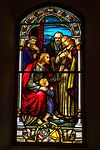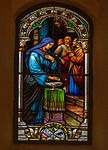Lutheran Church (Valtaiķi)
The Lutheran Church ( Valtaiķu Luterāņu baznīca ) in the Latvian village of Valtaiķi (Eng. Neuhausen) in the area of the parish ( pagasts ) Laidi in the district ( novads ) Kuldīga was built in 1792 in the classicistic style with Rococo elements. It is especially famous for the valuable stained glass on its 15 windows.
interior
Altar and pulpit from 1792 were built by Johann Friedrich Conradt (1747–1824) from Tilsit . The altar painting " Golgatha " by the painter Johann Lebrecht Eggink is considered to be one of the best from the 19th century and has the date 1833 in the signature. The 55 pipes of the organ are housed in 9 arched cases. The first organ was built by A. Martin in 1792. Today's organ by Carl Friedrich Wilhelm Böttcher dates from 1855. The tower contains two steel bells from 2007 with a diameter of 113 and 87 cm.
Historical predecessors
As early as the end of the 13th century, Neuhausen Castle ( Valtaiķu pils ) had a chapel with its own clergy, as was the case with all castles of the religious era. At Pentecost 1533, Bishop Hermann enfeoffed Johann Blomberg apart from four other pieces of land with the land at the St. Antonius Chapel in Neuhausen. The Neuhausen parish is said to have been founded by Bishop Magnus . Not much is known about the early church buildings. A church visit from 1736 shows that the church was in good condition: the sacristy, a clapboard-roofed tower and the provisional transitional church for sale nearby. From this note it can be concluded that the old church was in disrepair. Other sources confirm that the tower of the wooden previous church collapsed at the time of the plague epidemic in 1710. The wooden church from 1736 was built during the tenure of Pastor Dietrich Christian Wölffer with financial support from the landowner Wilhelm Friedrich von den Brincken (1684–1752). In 1753 the church donor and church council von den Brincken was buried in the church's crypt. In the following years there were no major changes to the church structure. Today's stone church was built in 1792. The old altar, pulpit and gallery from 1695 have been replaced by new ones. In the following years the church was maintained by the Manteuffel family from Katzdangen, 5 km away.
The following has been recorded about the early pastors:
| from | to | Surname |
|---|---|---|
| 1568 | 1580 | Nicholas coot |
| around | 1622 | Dietrich Cornelius |
| to | 1622 | Better |
| 1639 | 1660 | Samuel Rhanäus I. |
| around | 1657 | Adjunct: Jacob Elverfeld |
| 1660 | 1697 | Arnold Grupenius I. |
| 1688 | 1697 | Adjunct: Ernst Dietrich Grupenius |
| 1697 | 1702 | Ernst Dietrich Grupenius |
| 1703 | 1711 | Michael Rhode |
| 1711 | 1721 | Georg Friedrich Wagner |
| 1722 | 1734 | Michael Crispini |
| 1735 | 1760 | Dietrich Christian Wölffer |
| 1760 | 1766 | Jakob Preiss |
| 1766 | 1772 | Georg Wilhelm Fabricius |
| 1773 | 1791 | Abraham Georg Mittelpfort |
| 1791 | 1850 | Traugott Ephraim Friedrich Katterfeld |
| 1820 | 1850 | Adjunct: Dr. Johann Friedrich Katterfeld |
| 1850 | 1869 | Dr. Johann Friedrich Katterfeld |
| 1869 | 1883 | Johann Robert Julius Weide |
| 1883 | 1884 | Friedrich Karl van Beuningen |
| 1884 | 1887 | Dr. Fedor Johann Ernst Schmidt |
| 1888 | 1900 | Johann Theodor Kersten |
| 1899 | 1900 | Adjunct: Karl Jeannot Otto Goldberg |
| 1900 | 1910 | Hermann Walter v. Gavel |
| 1911 | 1924 | Konrad Schulz |
| 1925 | 1939 | Reinhold Freiberg |
| 1939 | 1942 | Olģerds Robežnieks |
| 1942 | ? | Kārlis Daugulis |
Expansion in the 20th century
The church was part of the Kazdanga (Katzdangen) estate of the Manteuffel family. Katzdangen Castle burned down in the course of the Russian Revolution of 1905 . After the reconstruction, the owner Carl Baron Manteuffel-Szoege settled around 2000 Protestant German colonists from Volhynia on his lands. For these colonists, the church was renovated by the architect Leon Reynier. In particular, the 15 windows received new stained glass. The landowner maintained contact with the Latvian painter Vilhelms Purvītis , whose paintings were lost in the fire. Purvītis helped design the new church windows, which were made in Italy by a Munich master. The four windows of the altar apse contain allegorical representations of the knightly virtues. The motifs in the nave come from the New Testament . All windows contain heraldic representations with the coats of arms of the Manteuffel family and related noble families.
Stained glass
The order of the pictures follows clockwise from the sacristy to the pulpit:
The parish in the past
In 1938 the community consisted of 4,400 members. That year there were 72 baptisms, 89 confirmations (including the parish in Rudbārži (Rudbahren)), 36 weddings and 54 funerals. 27% of the parishioners attended the sacrament.
Today's parish
As a result of the Hitler-Stalin Pact , the German community members were resettled in 1939. After that, the church, the pastorate and associated lands were handed over to the Latvian state. After the Latvian state was detached from the Soviet Union, the parishes were allowed to obtain the restitution of the former church property from the Latvian state. Since the Valtaiķi parish, like the Aizpute parish, is independent of the regional church ( LELB ) ( autonoma draudze ), there was a legal dispute over property rights. The property was awarded to the regional church. The lease income from 14 hectares of land can therefore not be used to support the pastor. The foundations from Germany, which enabled the Valtaiķi parish to restore the building in 2002, have also passed into the ownership of the regional church.
See also
literature
- Baltic Historical Commission (ed.): Entry to Schulz, Konrad * Albert Georg Hermann. In: BBLD - Baltic Biographical Lexicon digital
- Carl Baron Manteuffel-Szoege: My settlement work in Courland , 1941. ( Online )
- Ernests Ķiploks: Dzimtenes draudzes un baznīcas . Latviešu Evangelical Lutheran baznīcas America apgāds, 1987.
- Vitolds Mašnovskis: Latvijas Luterāņu Baznīcas , Volume 4. 2005, ISBN 9984-19-829-4
- Theodor Kallmeyer: The Evangelical Churches and Preachers of Courland , Riga 1910
Web links
Individual evidence
- ↑ Sigurds Rusmanis / Ivars Vīks: Kurzeme , Izdevniecība Latvijas Enciklopēdija, Rīga 1993, Chapter 6, Item 403.
- ↑ On the back of the altar there is a note with the text: This church work is made in 1792 by Joh: Friedr: Conradt carpenter master in Goldingen .
- ↑ The signature is: Johannes Eggink Curonis pinxit AD 1833 .
- ↑ Mašnovskis, page 298.
- ↑ Mašnovskis, page 298.
- ↑ Ķiploks, page 473.
- ↑ Mašnovskis page 298: The magnificent epitaph of Wilhelm Friedrich von den Brincken was brought to the Ruhenthal Castle as a museum piece .
- ↑ Mašnovskis, page 294.
- ↑ Kallmeyer, page 157f.
- ^ Baltic Historical Commission (ed.): Entry on Dietrich Christian Wölffer. In: BBLD - Baltic Biographical Lexicon digital Dietrich Christian Wölffer studied theology in Wittenberg in 1708. In addition to his position as pastor in Neuhausen, he was superintendent of the Piltener Kreis. He died in 1760.
- ^ Baltic Historical Commission (ed.): Entry on Traugott Ephraim Friedrich Katterfeld. In: BBLD - Baltic biographical encyclopedia digital Traugott Ephraim Friedrich Katterfeld lived from 1760 to 1850. He introduced the rhubarb in Courland and promoted the cultivation of potatoes.
- ^ Baltic Historical Commission (ed.): Entry on Dr. Johann Friedrich Katterfeld. In: BBLD - Baltic Biographical Lexicon digital Dr. Johann Friedrich Katterfeld lived from 1784 to 1869 and received his doctorate in Jena in 1819.
- ^ Inland, May 22nd, 1910 : Hermann Walter v. Gavel lived from 1858 to 1910 and came from Wolmar . After studying in Dorpat, he managed the Seemuppen estate and later decided to pursue an extended degree in theology, which he completed in 1899. In Rudbahren he looked after the first purely German parish in Courland.
- ^ Baltic Historical Commission (ed.): Entry on Konrad Schulz. In: BBLD - Baltic biografisches Lexikon digital Konrad Schulz lived from 1880 to 1944. During the First World War he was charged with high treason and imprisoned in the prisons of Tuckum and Moscow . In 1916 he was acquitted by the court martial and worked as vicar of the Katharinengemeinde in Saint Petersburg , then until 1917 as vicar in Strelna and Peterhof Palace . From 1917 to 1918 he lived in Dorpat and then returned to Neuhausen. From 1925 he worked as a vicar in Riga . Together with the resettlement of the Hirschenhof colony , he came to Gnesen in the Warthegau , where he worked as a pastor until his death.
- ↑ Reinhold Freiberg lived from 1898 to 1982. In 1939, like his community, he took part in the resettlement.
- ↑ Ķiploks page 474: Olģerds Robežnieks was introduced on December 15, 1939 and suspended his parish in 1941 during the German occupation, joined the Legion until he was released on April 1, 1942. On October 25, 1959 he resigned from the pastor's office to be more atheistic To become a teacher.
- ↑ Baznīcas Ziņas Nr.29 (October 18, 1942) and Ķiploks page 474: Kārlis Daugulis comes from Mazsalaca and lived from 1914 to 1975. In 1940 he finished his theology studies at the Latvian University . On June 21, 1942 he was appointed pastor for the parishes of Rudbahren (Rudbarži) and Neuhausen and was installed on October 18, 1942 by Provost Valters. There is uncertainty about the further course of his term of office.
- ↑ Mašnovskis follows the assessment of the art historian Skaidrīte Cielava that a studio for glass painting in Riga under the direction of Ernst Tode was responsible for the production. This contradicts all other known sources. However, Ernst Friedrich Tode (1858–1932) moved to Munich in 1908. It is therefore possible that he is this master.
- ↑ Rigasche Rundschau of June 11, 1928 .
- ↑ Manteuffel: The Latvian uproar in my settlement work in Courland .
- ↑ Detailed descriptions of the stained glass at Mašnovskis, page 294ff.
- ↑ Ķiploks, page 474.
- ↑ On the cause of the autonomy of Latvian parishes .
- ↑ "Žurnāls ir", June 2, 2016 ( memento of the original of September 28, 2016 in the Internet Archive ) Info: The archive link was inserted automatically and has not yet been checked. Please check the original and archive link according to the instructions and then remove this notice. Tiesa Valtaiķu baznīcas īpašumus atdod LELB (Monta Glumane writes about the transfer of property to the regional church).
- ↑ “Latvijas avīze”, April 13, 2015 Arta Drēziņa writes about the autonomy of the municipality.
- ^ Projects of the knighthoods: 2002 renewal of the church .
Coordinates: 56 ° 41 ′ 51 ″ N , 21 ° 48 ′ 0 ″ E















